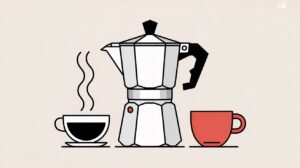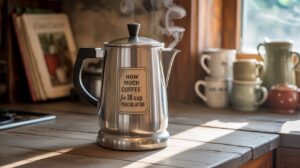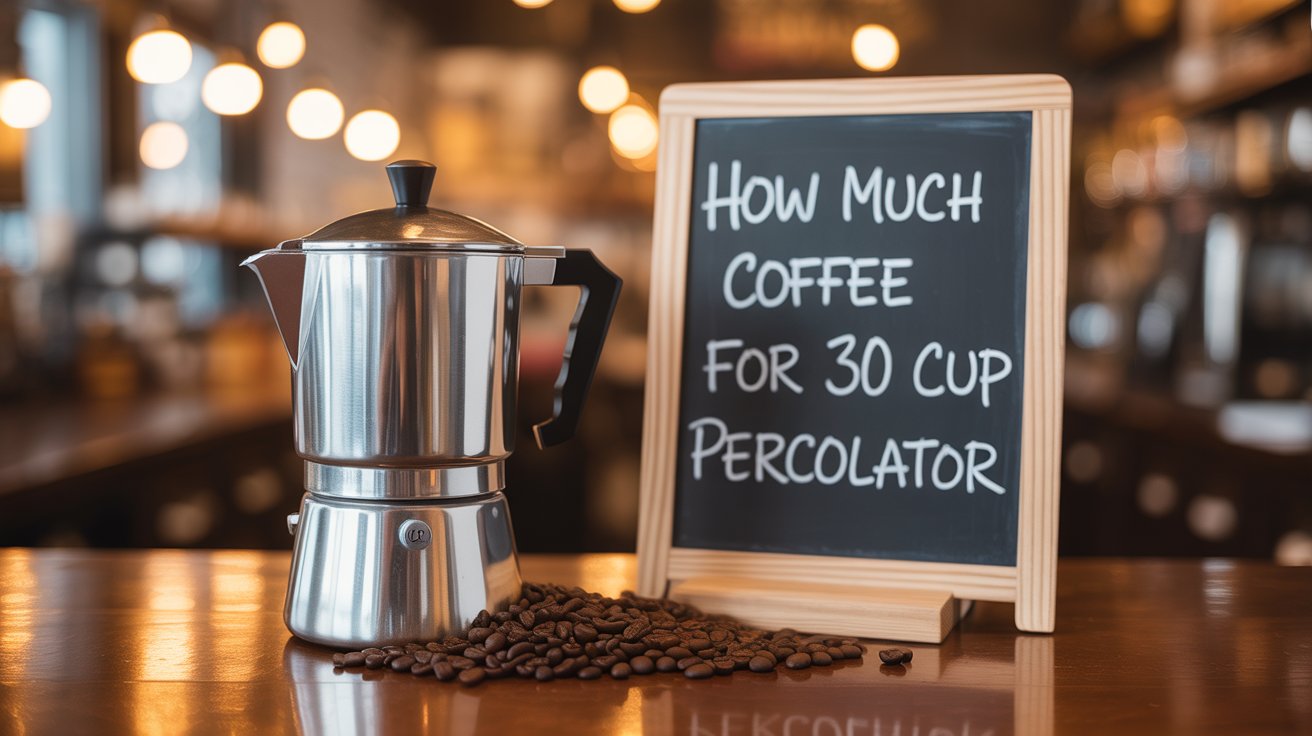Brew 2½ cups of ground coffee for a perfect 30-cup percolator.
That’s about 48 tablespoons — enough for rich, crowd-pleasing flavor without the bitterness.
I learned this the hard way. At my first church event, I eyeballed the grounds and ended up with coffee so weak it tasted like hot water. The right ratio makes or breaks a big batch — and with a percolator, even a small misstep gets magnified.
In the next few minutes, I’ll show you the exact measurements, the strength tweaks, and the pro tricks that guarantee your guests leave saying, “Best coffee ever.”
What Is a 30-Cup Percolator, and Who Uses It?
A 30-cup percolator is a large-capacity coffee maker built to brew for crowds. Instead of making one pot at a time, it delivers enough coffee for 20–30 people in a single run.
Think stainless steel urn with a tall, cylindrical design. Inside, water heats and cycles through the coffee grounds repeatedly until the perfect strength is reached.
Common Use Cases: Events, Churches, Offices, Camps
You’ll see 30-cup percolators wherever coffee needs to flow non-stop:
Church gatherings — post-service socials where coffee is the main social glue.
Office break rooms — fueling morning meetings or all-day work sessions.
Camps and retreats — rugged, high-volume brewing without needing fancy equipment.
Weddings & events — caterers use them because they’re predictable, fast, and easy to transport.
Pro tip: If you’re brewing for a group, always factor in refills. Thirty cups might serve only 15 people if they’re topping up often.
Differences From Standard Drip Coffee Machines
| Feature | 30-Cup Percolator | Standard Drip Machine |
|---|---|---|
| Capacity | 30+ cups at once | 4–12 cups |
| Brewing Method | Recirculates hot water through grounds multiple times | Single-pass hot water over grounds |
| Durability | Built for transport and volume brewing | Designed for countertop, smaller scale |
| Taste Profile | Bolder, sometimes stronger | Milder, cleaner flavor |
Percolators shine when you need bulk coffee with minimal fuss. Drip machines excel for smaller, controlled batches.
Brewing the Perfect 30-Cup Batch: Step-by-Step

Perfect coffee at this scale is part science, part craft. Follow these steps and you’ll avoid both “muddy water” and “rocket fuel” outcomes.
1. Gather Your Tools: Coffee, Water, Filters, Urn
Freshly ground medium-coarse coffee
Clean, cold water
Filter basket (or paper filter if your model allows)
30-cup percolator urn
Measuring scoop or digital scale
Pro tip: Skip soft water — it can make coffee taste flat. Use filtered but mineral-rich water for the best flavor.
2. Add the Right Amount of Grounds
For a 30-cup batch, use 2½ cups of ground coffee (≈ 48 tablespoons or ~270 grams).
This yields a medium-strength brew most people enjoy.
| Strength | Coffee (cups) | Coffee (tablespoons) | Coffee (grams) |
|---|---|---|---|
| Mild | 2.0 | 38 | 216 |
| Medium | 2.5 | 48 | 270 |
| Strong | 3.0 | 58 | 324 |
Adjust based on your audience’s preference. Camps and construction crews often prefer stronger coffee; corporate settings lean milder.
3. Brew Time Guide (How Long It Takes)
Expect 1 minute per cup for most percolators. That’s roughly 25–30 minutes for a full urn.
Start the brew 40 minutes before serving — it gives time for brewing plus a short settling period.
Resist the temptation to lift the lid mid-brew; it disrupts the cycle and can weaken flavor.
4. Serving Tips & Keeping Coffee Warm
Stir gently before serving — percolator coffee can stratify, with stronger coffee at the bottom.
Keep heat on “warm” to avoid burning; overcooked coffee tastes bitter fast.
Serve in pre-warmed cups to help maintain temperature.
Coffee Strength Matters: Adjusting for Taste

The perfect cup isn’t one-size-fits-all. A construction crew at 6 a.m. wants rocket fuel. A wedding brunch crowd? Not so much.
For a 30-cup percolator, the baseline is 2½ cups of ground coffee (≈ 48 tablespoons / ~270 grams). That’s a balanced medium roast most people enjoy. From there, tweak to match your crowd:
Mild, Medium, Strong – How to Modify Ratios
| Strength | Coffee (cups) | Coffee (tablespoons) | Coffee (grams) |
|---|---|---|---|
| Mild | 2.0 | 38 | 216 |
| Medium | 2.5 | 48 | 270 |
| Strong | 3.0 | 58 | 324 |
Pro tip: If you’re unsure, start medium and put sugar, cream, and flavored syrups on the side. It’s easier to mellow coffee than make it bolder after brewing.
What Happens If You Use Too Much or Too Little?
Too Much Coffee: Over-extraction kicks in. You’ll get bitterness, a harsh aftertaste, and sometimes a burnt aroma. Guests will sip once, then reach for water.
Too Little Coffee: Under-extraction leaves you with watery, flat coffee that tastes more like tinted hot water than a morning wake-up.
I’ve tested this at events — strong batches get finished first, but “too strong” can cause waste. Weak coffee almost always gets complaints.
Common Mistakes People Make with Percolators
A percolator basket has a limit for a reason. Overstuffing grounds clogs water flow, leading to uneven brewing and sludgy cups. Overfilling water? That dilutes the brew and increases spill risk during heating.
Using Wrong Grind Size
Too fine (espresso grind) and you’ll get muddy, over-extracted coffee. Too coarse and the flavor will be weak. Aim for a medium-coarse grind — slightly coarser than drip, but not as chunky as French press.
Not Preheating or Cleaning the Machine
Brewing into a cold urn can steal heat from the water, slowing extraction and producing a flat taste. Rinse the urn with hot water before adding coffee.
And clean after every use — old oils and residue can add a rancid note to your next batch. I’ve seen church urns that made every cup taste “off” simply because no one deep-cleaned them in months.
Read Also:
Can You Use Pre-Ground Coffee? Tips for Best Results
Yes — you can absolutely use pre-ground coffee in a 30-cup percolator. But whether it tastes great depends on the grind, freshness, and how you store it.
Best Type of Grind for Percolators
Percolators work best with a medium-coarse grind — about the texture of coarse sand.
Too fine and you’ll end up with sludge and bitterness.
Too coarse and you’ll get weak, watery coffee.
If you’re buying pre-ground coffee, look for packaging that specifically mentions “percolator” or “coarse grind.” If it only says “drip,” it’s usually slightly finer but still usable if you watch brew time.
Store-Bought vs. Freshly Ground: Taste Differences
Freshly ground beans almost always win in flavor. The oils that make coffee taste rich start breaking down within 15 minutes of grinding.
Freshly ground: Brighter aroma, richer taste, and more complexity.
Store-bought pre-ground: Convenient, consistent, and good for large events — but slightly muted flavor.
Pro tip: If you must use pre-ground, buy in smaller quantities and store it in an airtight container away from light and heat. Oxygen is your coffee’s worst enemy.
Expert Brewing Tips from Baristas & Hosts
Professionals often brew slightly milder than their personal taste. It’s easier to let guests add strength with extras (espresso shots, strong concentrate) than to fix overly strong coffee.
Flavor Enhancers (Cinnamon, Vanilla, Salt Hack)
Cinnamon stick in the basket for subtle warmth.
Vanilla bean or a drop of pure extract in the urn for sweetness without sugar.
Tiny pinch of salt in the grounds to smooth bitterness.
These tricks are common in catering — they add a signature touch without overpowering the coffee.
Avoiding Bitter or Burnt Coffee
Keep the percolator on warm after brewing — never let it keep cycling.
Don’t brew too far in advance; percolated coffee declines after about 2 hours.
Use fresh, cold water — hot tap water can pick up minerals that affect taste.
Real-world tip: At one corporate event, the coffee was brewed at 6 a.m. and served at 10 a.m. It was so bitter people lined up at the tea station instead. Fresh timing matters.
conclusion
Brew it right, and your 30-cup percolator becomes a crowd-pleaser, not a caffeine gamble. Stick to the recommended ratio, tweak for taste, and you’ll serve coffee that actually gets remembered.
FAQs
How many scoops of coffee for 30 cups?
Use 48 tablespoons (about 2½ cups) for medium strength. That’s roughly 24 standard coffee scoops.
How long does it take to brew 30 cups in a percolator?
Around 25–30 minutes, depending on the model. Count on 1 minute per cup.
Can I use instant coffee instead?
Yes, but it’s not recommended. Instant coffee won’t brew the same way and lacks the depth of freshly brewed grounds.
How strong is percolator coffee compared to drip?
Percolator coffee is typically bolder and more robust because water cycles through the grounds multiple times. Drip coffee is milder and cleaner in flavor.

Shahriar brings a unique blend of storytelling prowess and digital expertise to Daily Coffee Guide. With a background in SEO and content strategy, he ensures our articles on Beans, Coffee, Tea, and Drinks are both engaging and discoverable. His passion for coffee culture drives him to explore and share the rich narratives behind every cup.

